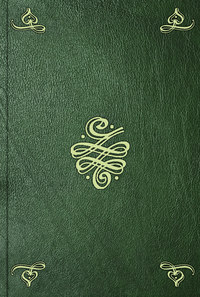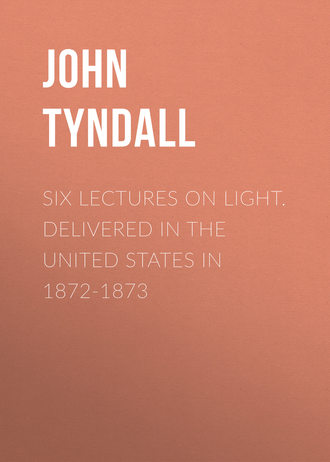 полная версия
полная версияSix Lectures on Light. Delivered In The United States In 1872-1873
Not in a moment are great theories elaborated: the facts which demand them become first prominent; then, to the period of observation succeeds a period of pondering and of tentative explanation. By such efforts the human mind is gradually prepared for the final theoretic illumination. The colours of thin plates, for example, occupied the attention of Robert Boyle. In his 'Experimental History of Colours' he contends against the schools which affirmed that colour was 'a penetrative quality that reaches to the innermost parts of the object,' adducing opposing facts. 'To give you a first instance,' he says, 'I shall need but to remind you of what I told you a little after the beginning of this essay, touching the blue and red and yellow that may be produced upon a piece of tempered steel; for these colours, though they be very vivid, yet if you break the steel they adorn, they will appear to be but superficial.' He then describes, in phraseology which shows the delight he took in his work, the following beautiful experiment:—
'We took a quantity of clean lead, and melted it with a strong fire, and then immediately pouring it out into a clean vessel of convenient shape and matter (we used one of iron, that the great and sudden heat might not injure it), and then carefully and nimbly taking off the scum that floated on the top, we perceived, as we expected, the smooth and glossy surface of the melted matter to be adorned with a very glorious colour, which, being as transitory as delightful, did almost immediately give place to another vivid colour, and that was as quickly succeeded by a third, and this, as it were, chased away by a fourth; and so these wonderfully vivid colours successively appeared and vanished till the metal ceasing to be hot enough to hold any longer this pleasing spectacle, the colours that chanced to adorn the surface when the lead thus began to cool remained upon it, but were so superficial that how little soever we scraped off the surface of the lead, we did, in such places, scrape off all the colour.' 'These things,' he adds, 'suggested to me some thoughts or ravings which I have not now time to acquaint you with.'13
He extends his observations to essential oils and spirits of wine, 'which being shaken till they have good store of bubbles, those bubbles will (if attentively considered) appear adorned with various and lovely colours, which all immediately vanish upon the retrogressing of the liquid which affords these bubbles their skins into the rest of the oil.' He also refers to the colour of glass films. 'I have seen one that was skilled in fashioning glasses by the help of a lamp blowing some of them so strongly as to burst them; whereupon it was found that the tenacity of the metal was such that before it broke it suffered itself to be reduced into films so extremely thin that they constantly showed upon their surface the varying colours of the rainbow.'14
Subsequent to Boyle the colours of thin plates occupied the attention of Robert Hooke, in whose writings we find a dawning of the undulatory theory of light. He describes with great distinctness the colours obtained with thin flakes of 'Muscovy glass' (talc), also those surrounding flaws in crystals where optical continuity is destroyed. He shows very clearly the dependence of the colour upon the thickness of the film, and proves by microscopic observation that plates of a uniform thickness yield uniform colours. 'If,' he says, 'you take any small piece of the Muscovy glass, and with a needle, or some other convenient instrument, cleave it oftentimes into thinner and thinner laminæ, you shall find that until you come to a determinate thinness of them they shall appear transparent and colourless; but if you continue to split and divide them further, you shall find at last that each plate shall appear most lovely tinged or imbued with a determinate colour. If, further, by any means you so flaw a pretty thick piece that one part begins to cleave a little from the other, and between these two there be gotten some pellucid medium, those laminated or pellucid bodies that fill that space shall exhibit several rainbows or coloured lines, the colours of which will be disposed and ranged according to the various thicknesses of the several parts of the plate.' He then describes fully and clearly the experiment with pressed glasses already referred to:—
'Take two small pieces of ground and polished looking-glass plate, each about the bigness of a shilling: take these two dry, and with your forefingers and thumbs press them very hard and close together, and you shall find that when they approach each other very near there will appear several irises or coloured lines, in the same manner almost as in the Muscovy glass; and you may very easily change any of the colours of any part of the interposed body by pressing the plates closer and harder together, or leaving them more lax—that is, a part which appeared coloured with a red, may presently be tinged with a yellow, blue, green, purple, or the like. 'Any substance,' he says, 'provided it be thin and transparent, will show these colours.' Like Boyle, he obtained them with glass films; he also procured them with bubbles of pitch, rosin, colophony, turpentine, solutions of several gums, as gum arabic in water, any glutinous liquor, as wort, wine, spirit of wine, oyl of turpentine, glare of snails, &c.
Hooke's writings show that even in his day the idea that both light and heat are modes of motion had taken possession of many minds. 'First,' he says, 'that all kind of fiery burning bodies have their parts in motion I think will be easily granted me. That the spark struck from a flint and steel is in rapid agitation I have elsewhere made probable;… that heat argues a motion of the internal parts is (as I said before) generally granted;… and that in all extremely hot shining bodies there is a very quick motion that causes light, as well as a more robust that causes heat, may be argued from the celerity wherewith the bodies are dissolved. Next, it must be a vibrative motion.' His reference to the quick motion of light and the more robust motion of heat is a remarkable stroke of sagacity; but Hooke's direct insight is better than his reasoning; for the proofs he adduces that light is 'a vibrating motion' have no particular bearing upon the question.
Still the Undulatory Theory had undoubtedly dawned upon the mind of this remarkable man. In endeavouring to account for the colours of thin plates, he again refers to the relation of colour to thickness: he dwells upon the fact that the film which shows these colours must be transparent, proving this by showing that however thin an opaque body was rendered no colours were produced. 'This,' he says, 'I have often tried by pressing a small globule of mercury between two smooth plates of glass, whereby I have reduced that body to a much greater thinness than was requisite to exhibit the colours with a transparent body.' Then follows the sagacious remark that to produce the colours 'there must be a considerable reflecting body adjacent to the under or further side of the lamina or plate: for this I always found, that the greater that reflection was the more vivid were the appearing colours. From which observation,' he continues, 'it is most evident, that the reflection from the further or under side of the body is the principal cause of the production of these colours.'
He draws a diagram, correctly representing the reflection at the two surfaces of the film; but here his clearness ends. He ascribes the colours to a coalescence or confusion of the two reflecting pulses; the principal of interference being unknown to him, he could not go further in the way of explanation.
§ 8. Newton's Rings. Relation of Colour to Thickness of Film

Fig. 13
In this way, then, by the active operation of different minds, facts are observed, examined, and the precise conditions of their appearance determined. All such work in science is the prelude to other work; and the efforts of Boyle and Hooke cleared the way for the optical career of Newton. He conquered the difficulty which Hooke had found insuperable, and determined by accurate measurements the relation of the thickness of the film to the colour it displays. In doing this his first care was to obtain a film of variable and calculable depth. On a plano-convex glass lens (D B E, fig. 13) of very feeble curvature he laid a plate of glass (A C) with a plane surface, thus obtaining a film of air of gradually increasing depth from the point of contact (B) outwards. On looking at the film in monochromatic light he saw, with the delight attendant on fulfilled prevision, surrounding the place of contact, a series of bright rings separated from each other by dark ones, and becoming more closely packed together as the distance from the point of contact augmented (as in fig. 14). When he employed red light, his rings had certain diameters; when he employed blue light, the diameters were less. In general terms, the more refrangible the light the smaller were the rings. Causing his glasses to pass through the spectrum from red to blue, the rings gradually contracted; when the passage was from blue to red, the rings expanded. This is a beautiful experiment, and appears to have given Newton the most lively satisfaction. When white light fell upon, the glasses, inasmuch as the colours were not superposed, a series of iris-coloured circles was obtained. A magnified image of Newton's rings is now before you, and, by employing in succession red, blue, and white light, we obtain all the effects observed by Newton. You notice that in monochromatic light the rings run closer and closer together as they recede from the centre. This is due to the fact that at a distance the film of air thickens more rapidly than near the centre. When white light is employed, this closing up of the rings causes the various colours to be superposed, so that after a certain thickness they are blended together to white light, the rings then ceasing altogether. It needs but a moment's reflection to understand that the colours of thin plates, produced by white light, are never unmixed or monochromatic.
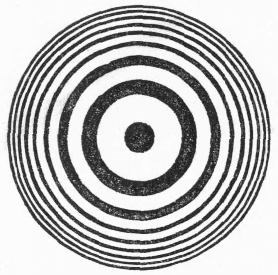
Fig. 14
Newton compared the tints obtained in this way with the tints of his soap-bubble, and he calculated the corresponding thickness. How he did this may be thus made plain to you: Suppose the water of the ocean to be absolutely smooth; it would then accurately represent the earth's curved surface. Let a perfectly horizontal plane touch the surface at any point. Knowing the earth's diameter, any engineer or mathematician in this room could tell you how far the sea's surface will lie below this plane, at the distance of a yard, ten yards, a hundred yards, or a thousand yards from the point of contact of the plane and the sea. It is common, indeed, in levelling operations, to allow for the curvature of the earth. Newton's calculation was precisely similar. His plane glass was a tangent to his curved one. From its refractive index and focal distance he determined the diameter of the sphere of which his curved glass formed a segment, he measured the distances of his rings from the place of contact, and he calculated the depth between the tangent plane and the curved surface, exactly as the engineer would calculate the distance between his tangent plane and the surface of the sea. The wonder is, that, where such infinitesimal distances are involved, Newton, with the means at his disposal, could have worked with such marvellous exactitude.
To account for these rings was the greatest optical difficulty that Newton, ever encountered. He quite appreciated the difficulty. Over his eagle eye there was no film—no vagueness in his conceptions. At the very outset his theory was confronted by the question, Why, when a beam of light is incident on a transparent body, are some of the light-particles reflected and some transmitted? Is it that there are two kinds of particles, the one specially fitted for transmission and the other for reflection? This cannot be the reason; for, if we allow a beam of light which has been reflected from one piece of glass to fall upon another, it, as a general rule, is also divided into a reflected and a transmitted portion. The particles once reflected are not always reflected, nor are the particles once transmitted always transmitted. Newton saw all this; he knew he had to explain why it is that the self-same particle is at one moment reflected and at the next moment transmitted. It could only he through some change in the condition of the particle itself. The self-same particle, he affirmed, was affected by 'fits' of easy transmission and reflection.
§ 9. Theory of 'Fits' applied to Newton's Rings
If you are willing to follow me in an attempt to reveal the speculative groundwork of this theory of fits, the intellectual discipline will, I think, repay you for the necessary effort of attention. Newton was chary of stating what he considered to be the cause of the fits, but there can hardly be a doubt that his mind rested on a physical cause. Nor can there be a doubt that here, as in all attempts at theorising, he was compelled to fall back upon experience for the materials of his theory. Let us attempt to restore his course of thought and observation. A magnet would furnish him with the notion of attracted and repelled poles; and he who habitually saw in the visible an image of the invisible would naturally endow his light-particles with such poles. Turning their attracted poles towards a transparent substance, the particles would be sucked in and transmitted; turning their repelled poles, they would be driven away or reflected. Thus, by the ascription of poles, the transmission and reflection of the self-same particle at different times might be accounted for.
Consider these rings of Newton as seen in pure red light: they are alternately bright and dark. The film of air corresponding to the outermost of them is not thicker than an ordinary soap-bubble, and it becomes thinner on approaching the centre; still Newton, as I have said, measured the thickness corresponding to every ring, and showed the difference of thickness between ring and ring. Now, mark the result. For the sake of convenience, let us call the thickness of the film of air corresponding to the first dark ring d; then Newton found the distance corresponding to the second dark ring 2 d; the thickness corresponding to the third dark ring 3 d; the thickness corresponding to the tenth dark ring 10 d, and so on. Surely there must be some hidden meaning in this little distance, d, which turns up so constantly? One can imagine the intense interest with which Newton pondered its meaning. Observe the probable outcome of his thought. He had endowed his light-particles with poles, but now he is forced to introduce the notion of periodic recurrence. Here his power of transfer from the sensible to the subsensible would render it easy for him to suppose the light-particles animated, not only with a motion of translation, but also with a motion of rotation. Newton's astronomical knowledge rendered all such conceptions familiar to him. The earth has such a double motion. In the time occupied in passing over a million and a half of miles of its orbit—that is, in twenty-four hours—our planet performs a complete rotation; and in the time required to pass over the distance d, Newton's light-particle might be supposed to perform a complete rotation. True, the light-particle is smaller than the planet, and the distance d, instead of being a million and a half of miles, is a little over the ninety thousandth of an inch. But the two conceptions are, in point of intellectual quality, identical.
Imagine, then, a particle entering the film of air where it possesses this precise thickness. To enter the film, its attracted end must be presented. Within the film it is able to turn once completely round; at the other side of the film its attracted pole will be again presented; it will, therefore, enter the glass at the opposite side of the film and be lost to the eye. All round the place of contact, wherever the film possesses this precise thickness, the light will equally disappear—we shall therefore have a ring of darkness.
And now observe how well this conception falls in with the law of proportionality discovered by Newton. When the thickness of the film is 2 d, the particle has time to perform, two complete rotations within the film; when the thickness is 3 d, three complete rotations; when 10 d, ten complete rotations are performed. It is manifest that in each of these cases, on arriving at the second surface of the film, the attracted pole of the particle will be presented. It will, therefore, be transmitted; and, because no light is sent to the eye, we shall have a ring of darkness at each of these places.
The bright rings follow immediately from the same conception. They occur between the dark rings, the thicknesses to which they correspond being also intermediate between those of the dark ones. Take the case of the first bright ring. The thickness of the film is ½d; in this interval the rotating particle can perform only half a rotation. When, therefore, it reaches the second surface of the film, its repelled pole is presented; it is, therefore, driven back and reaches the eye. At all distances round the centre corresponding to this thickness the same effect is produced, and the consequence is a ring of brightness. The other bright rings are similarly accounted for. At the second one, where the thickness is 1½d, a rotation and a half is performed; at the third, two rotations and a half; and at each of these places the particles present their repelled poles to the lower surface of the film. They are therefore sent back to the eye, and produce there the impression of brightness. This analysis, though involving difficulties when closely scrutinised, enables us to see how the theory of fits may have grown into consistency in the mind of Newton.
It has been already stated that the Emission Theory assigned a greater velocity to light in glass and water than in air or stellar space; and that on this point it was at direct issue with the theory of undulation, which makes the velocity in air or stellar space greater than in glass or water. By an experiment proposed by Arago, and executed with consummate skill by Foucault and Fizeau, this question was brought to a crucial test, and decided in favour of the theory of undulation.
In the present instance also the two theories are at variance. Newton assumed that the action which produces the alternate bright and dark rings took place at a single surface; that is, the second surface of the film. The undulatory theory affirms that the rings are caused by the interference of waves reflected from both surfaces. This also has been demonstrated by experiment. By a proper arrangement, as we shall afterwards learn, we may abolish reflection from one of the surfaces of the film, and when this is done the rings vanish altogether.
Rings of feeble intensity are also formed by transmitted light. These are referred by the undulatory theory to the interference of waves which have passed directly through the film, with others which have suffered two reflections within the film, and are thus completely accounted for.
§ 10. The Diffraction of Light
Newton's espousal of the Emission Theory is said to have retarded scientific discovery. It might, however, be questioned whether, in the long run, the errors of great men have not really their effect in rendering intellectual progress rhythmical, instead of permitting it to remain uniform, the 'retardation' in each case being the prelude to a more impetuous advance. It is confusion and stagnation, rather than error, that we ought to avoid. Thus, though the undulatory theory was held back for a time, it gathered strength in the interval, and its development within the last half century has been so rapid and triumphant as to leave no rival in the field. We have now to turn to the investigation of new classes of phenomena, of which it alone can render a satisfactory account.
Newton, who was familiar with the idea of an ether, and who introduced it in some of his speculations, objected, as already stated, that if light consisted of waves shadows could not exist; for that the waves would bend round the edges of opaque bodies and agitate the ether behind them. He was right in affirming that this bending ought to occur, but wrong in supposing that it does not occur. The bending is real, though in all ordinary cases it is masked by the action of interference. This inflection of the light receives the name of Diffraction.
To study the phenomena of diffraction it is necessary that our source of light should be a physical point, or a fine line; for when a luminous surface is employed, the waves issuing from different points of the surface obscure and neutralize each other. A point of light of high intensity is obtained by admitting the parallel rays of the sun through an aperture in a window-shutter, and concentrating the beam by a lens of short focus. The small solar image at the focus constitutes a suitable point of light. The image of the sun formed on the convex surface of a glass bead, or of a watch-glass blackened within, though less intense, will also answer. An intense line of light is obtained by admitting the sunlight through a slit and sending it through a strong cylindrical lens. The slice of light is contracted to a physical line at the focus of the lens. A glass tube blackened within and placed in the light, reflects from its surface a luminous line which, though less intense, also answers the purpose.
In the experiment now to be described a vertical slit of variable width is placed in front of the electric lamp, and this slit is looked at from a distance through another vertical slit, also of variable aperture, and held in the hand.
The light of the lamp being, in the first place, rendered monochromatic by placing a pure red glass in front of the slit, when the eye is placed in the straight line drawn through both slits an extraordinary appearance (shown in fig. 15) is observed. Firstly, the slit in front of the lamp is seen as a vivid rectangle of light; but right and left of it is a long series of rectangles, decreasing in vividness, and separated from each other by intervals of absolute darkness.
The breadth of these bands is seen to vary with the width of the slit held before the eye. When the slit is widened the bands become narrower, and crowd more losely together; when the slit is narrowed, the individual bands widen and also retreat from each other, leaving between them wider spaces of darkness than before.
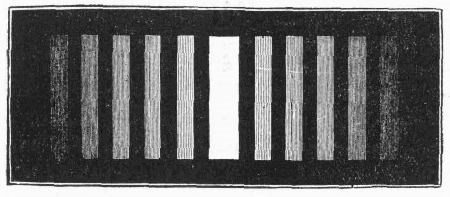
Fig. 15.
Leaving everything else unchanged, let a blue glass or a solution of ammonia-sulphate of copper, which gives a very pure blue, be placed in the path of the light. A series of blue bands is thus obtained, exactly like the former in all respects save one; the blue rectangles are narrower, and they are closer together than the red ones.
If we employ colours of intermediate refrangibilities, which we may do by causing the different colours of a spectrum to shine through the slit, we obtain bands of colour intermediate in width, and occupying intermediate positions, between those of the red and blue. The aspect of the bands in red, green, and violet light is represented in fig. 16. When white light, therefore, passes through the slit the various colours are not superposed, and instead of a series of monochromatic bands, separated from each other by intervals of darkness, we have a series of coloured spectra placed side by side. When the distant slit is illuminated by a candle flame, instead of the more intense electric light, or when a distant platinum wire raised to a white heat by an electric current is employed, substantially the same effects are observed.
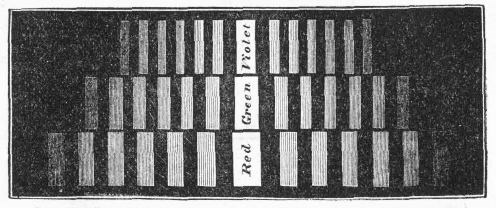
Fig. 16.




